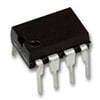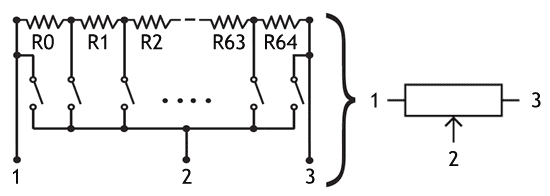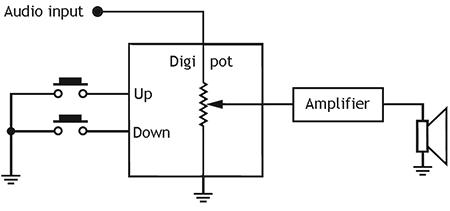- Network Sites:
-
 EEPower Day is a free 1-day virtual conference. Learn More
EEPower Day is a free 1-day virtual conference. Learn More
 A digital potentiometer (also known as digital resistor) has the same function as a normal potentiometer but instead of mechanical action it uses digital signals and switches. This is often done by making use of a resistor ladder, a string of small resistors in series. At every step of the ladder, an electronic switch is present. Only one switch is closed at any time. The closed switch determines the "wiper" position and the resistance ratio. This resistive ladder digital potentiometer is an example of a linear taper. The amount of steps in the ladder determines the resolution of the digital pot. The figure below shows the working principle of a digital potentiometer with 64 steps. Digital resistors can be controlled by using simple up/down signals or by serial communication protocols such as I²C or SPI.
A digital potentiometer (also known as digital resistor) has the same function as a normal potentiometer but instead of mechanical action it uses digital signals and switches. This is often done by making use of a resistor ladder, a string of small resistors in series. At every step of the ladder, an electronic switch is present. Only one switch is closed at any time. The closed switch determines the "wiper" position and the resistance ratio. This resistive ladder digital potentiometer is an example of a linear taper. The amount of steps in the ladder determines the resolution of the digital pot. The figure below shows the working principle of a digital potentiometer with 64 steps. Digital resistors can be controlled by using simple up/down signals or by serial communication protocols such as I²C or SPI.
 Digital potentiometer design using resistor ladder
Digital potentiometer design using resistor ladderA digital potentiometer is a variable resistor which is controlled by digital signals instead of by mechanical movement.
Digital potentiometers are integrated circuit (ICs). Some variants have a nonvolatile memory (e.g., EEPROM or Flash) which remembers the potentiometer resistance setting. When there is no on-board memory, the initial position of the wiper is often the middle position. Because of their relatively small size compared to conventional potentiometers, multiple potentiometers can be packed on a single chip. Digitial potentiometer ICs with up to 6 channels are available.
The amount of steps available determines the resolution of the digital potentiometer. The following table lists common step values available, including the bit count:
| Number of steps | ||||||
| Bits | 5 | 6 | 7 | 8 | 9 | 10 |
| Steps | 32 | 64 | 128 | 256 | 512 | 1024 |
Digital resistors are available in a range of values, but 10 kΩ is the most commonly used. Other common values are 5, 50 and 100 kΩ. The standard tolerance is 20% but nowadays digital potentiometers with a tolerance down to 1% are available.
Something to take into account when you start working with digital potentiometers is the fact that most of them are rated at 5 V (to power the logic circuits). This can make it a bit tricky to use them as a direct replacement for conventional potentiometers.
Digital pots can be used in any application where a trimming potentiometer or preset-resistor is normally used. The big advantage is that they can be controlled in an automated closed loop. When used for tuning, re-calibration can be done by a a microcontroller at defined intervals. Digital potentiometers applications include brightness and contrast control of monitors, gain control, and Wheatstone bridges. The image below shows an example application of a digital potentiometer used for volume control. The potentiometer can be controlled via up/down signals, buttons, or a rotary encoder.
 Digital potentiometer used for a volume control application
Digital potentiometer used for a volume control application
I find it hard to understand how you can create 2^N different resistance values if only one switch can be closed at any time; instead, there would be just N different resistance levels. On the other hand, if you allow any combination of switches to be opened or closed, then it makes sense.
In addition, it would be great if you text would refer to the figure. I think nr 2 is the output and number 3 should be removed?